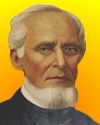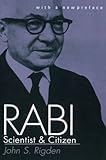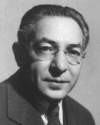 | TODAY IN SCIENCE HISTORY
NEWSLETTER - 11 JANUARY |
 On 11 Jan 1874, Gail Borden died, an American manufacturer, inventor and food scientist who is most remembered because he invented a commercial method of condensing milk to preserve it. He also devised a “meat biscuit” with meat extracts suitable for the meal rations of the military, and sailors, who needed a long-lasting food in an era before refrigeration. Today in Science History has a number of resources on Gail Borden with a page of links to more information on Gail Borden and his Inventions and patents. On 11 Jan 1874, Gail Borden died, an American manufacturer, inventor and food scientist who is most remembered because he invented a commercial method of condensing milk to preserve it. He also devised a “meat biscuit” with meat extracts suitable for the meal rations of the military, and sailors, who needed a long-lasting food in an era before refrigeration. Today in Science History has a number of resources on Gail Borden with a page of links to more information on Gail Borden and his Inventions and patents. |
 On 11 Jan 1988, Isador Rabi died, American Nobel prize-winning physicist who invented the atomic and molecular beam magnetic resonance method of measuring properties of atoms, molecules and atomic nuclei. [BOOKINFO} from the Harvard university Press. The New Scientist book review on this “‘statesman’ of science,” said that “Rabi’s life was remarkable, full of incident, vision and action, including war, hot and cold. The biography is a masterpiece, rich in anecdote and never losing the narrative drive.” It is available New from $29.76. Used from $10.89. (As of time of writing.). On 11 Jan 1988, Isador Rabi died, American Nobel prize-winning physicist who invented the atomic and molecular beam magnetic resonance method of measuring properties of atoms, molecules and atomic nuclei. [BOOKINFO} from the Harvard university Press. The New Scientist book review on this “‘statesman’ of science,” said that “Rabi’s life was remarkable, full of incident, vision and action, including war, hot and cold. The biography is a masterpiece, rich in anecdote and never losing the narrative drive.” It is available New from $29.76. Used from $10.89. (As of time of writing.). | | For picks from earlier newsletters, see the Today in Science History Science Store home page. | |
| All our scientific and philosophic ideals are altars to unknown gods. - William James, American psychologist and philosopher (born 11 Jan 1842).  |
 | Science itself is badly in need of integration and unification. The tendency is more and more the other way ... Only the graduate student, poor beast of burden that he is, can be expected to know a little of each. As the number of physicists increases, each specialty becomes more self-sustaining and self-contained. Such Balkanization carries physics, and indeed, every science further away, from natural philosophy, which, intellectually, is the meaning and goal of science. - Isidor Isaac Rabi, Austrian-American physicist (died 11 Jan 1988).  |
 | The cause of nutrition and growth resides not in the organism as a whole but in the separate elementary parts�the cells. - Theodor Schwann, German physiologist (died 11 Jan 1882).  |
| Before you look at today's web page, see if you can answer some of these questions about the events that happened on this day. Some of the names are very familiar. Others will likely stump you. Tickle your curiosity with these questions, then check your answers on today's web page. |
 | Laurens Hammond, born 11 Jan 1895, was an American businessman and inventor of the electronic keyboard instrument known as the Hammond organ. During WW II, Laurens helped design guided missile controls with patents for bomb guidance.
 In what decade was the Hammond organ patented? |
 | On 11 Jan 1889, Calvin Blackman Bridges was born, an American geneticist who advanced understanding of the role of chromosomes in heredity using Drosophila melanogaster as the subject species for study.
 What is the common name of Drosophila melanogaster? |
 | Carl David Anderson (1905-1991) was an American physicist who, with Victor Francis Hess of Austria, won the Nobel Prize for Physics in 1936 for his discovery of the first known particle of antimatter-the positron.
 What was the source of the positrons he found? |
 | Isidor Isaac Rabi (1898-1988) was a Nobel prize-winning Austrian-American physicist. His work led to the invention of the laser, the atomic clock, and diagnostic uses of nuclear magnetic resonance. He originated the idea for a nuclear research center in Geneva, Switzerland (founded 1954).
 Rabi originated the idea for which research center? |
| On 11 Jan 1964, a U.S. Surgeon General's Report was the subject of a press conference. It was America's first widely publicized official recognition of “a health hazard of sufficient importance in the United States to warrant appropriate remedial action.”
 What was this hazard? |
 | On 11 Jan 1787, William Herschel discovered the first moon of Uranus, six years after he had discovered the planet.
 What is the name of this moon? |
When you have your answers ready to all the questions above, you'll find all the information to check them, and more, on the January 11 web page of Today in Science History. Or, try this link first for just the brief answers.
Fast answers for the previous newsletter for January 10: cosmic microwave background radiation, remnant radiation from the “big bang” • if a series of sedimentary rocks has not been overturned, upper layers are younger and lower layers are older • in the chromosomes of the cell-kemels, also in cell plasma • Carolus Linnaeus • the “single,” 7-inch diameter 45 rpm record • Texas. |
 If you enjoy this newsletter, the website, or wish to offer encouragement or ideas, please send feedback by using your mail reader Reply button. If you enjoy this newsletter, the website, or wish to offer encouragement or ideas, please send feedback by using your mail reader Reply button.
Your click on a StumbleUpon, Google+ or Facebook social button on the site webpages is also a welcome sign of appreciation. Thank you for using them. |
To find citations for quotations go to the corresponding webpage by clicking on the “quotes” balloon icon. Sources for the thumbnails appear on today's webpage with the corresponding item.
� This newsletter is copyright 2014 by todayinsci.com. Please respect the Webmaster's wishes and do not put copies online of the Newsletter � or any Today in Science History webpage. (If you already have done so, please remove them. Thank you.) Offline use in education is encouraged such as a printout on a bulletin board, or projected for classroom viewing. Online, descriptive links to our pages are welcomed, as these will provide a reader with the most recent revisions, additions and/or corrections of a webpage. For any other copyright questions, please contact the Webmaster by using your mail reader Reply button. |
--
If you do not want to receive any more newsletters,
Unsubscribe To update your preferences and to unsubscribe visit
this link 


 On 11 Jan 1874, Gail Borden died, an American manufacturer, inventor and food scientist who is most remembered because he invented a commercial method of condensing milk to preserve it. He also devised a “meat biscuit” with meat extracts suitable for the meal rations of the military, and sailors, who needed a long-lasting food in an era before refrigeration. Today in Science History has a number of resources on Gail Borden with a page of links to more information on Gail Borden and his Inventions and patents.
On 11 Jan 1874, Gail Borden died, an American manufacturer, inventor and food scientist who is most remembered because he invented a commercial method of condensing milk to preserve it. He also devised a “meat biscuit” with meat extracts suitable for the meal rations of the military, and sailors, who needed a long-lasting food in an era before refrigeration. Today in Science History has a number of resources on Gail Borden with a page of links to more information on Gail Borden and his Inventions and patents. 


 In what decade was the Hammond organ patented?
In what decade was the Hammond organ patented? 
 What is the common name of Drosophila melanogaster?
What is the common name of Drosophila melanogaster? 
 What was the source of the positrons he found?
What was the source of the positrons he found? 
 Rabi originated the idea for which research center?
Rabi originated the idea for which research center?  What was this hazard?
What was this hazard? 
 What is the name of this moon?
What is the name of this moon?  If you enjoy this newsletter, the website, or wish to offer encouragement or ideas, please send feedback by using your mail reader Reply button.
If you enjoy this newsletter, the website, or wish to offer encouragement or ideas, please send feedback by using your mail reader Reply button. 

Δεν υπάρχουν σχόλια:
Δημοσίευση σχολίου